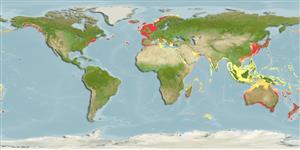Common names from other countries
Classification / Names / Names
Noms communs | Synonymes | Catalog of Fishes (gen., sp.) | ITIS | CoL | WoRMS
Environment: milieu / climate zone / depth range / distribution range
Écologie
Pélagique; profondeur 0 - 250 m (Ref. 1134). Subtropical; 7°C - 30°C (Ref. 1134)
Distribution
Pays | Zones FAO | Écosystèmes | Occurrences | Introductions
Atlantic, the Mediterranean and Indo-Pacific. Tropical to temperate.
Length at first maturity / Taille / Poids / Âge
Maturity: Lm ? range ? - ? cm Max length : 60.0 cm COLD mâle / non sexé; (Ref. 1610)
Minimum depth from Ref. 116065. Marine, planktonic; most plentiful below 250 m (Ref. 1134). Filter-feeder. Forms blooms (Ref. 130729).
Life cycle and mating behavior
Maturité | Reproduction | Frai | Œufs | Fécondité | Larves
Members of the order Pyrosomatida includes clonal and sexual phases in its life cycle. Life cycle: Eggs develop into lecithotrophic oozooid (cyathozooid) which undergo budding to form four blastozooids. The oozoid degenerates and the colony is formed from the blastozooids.
Kott, P. 2005. (Ref. 1134)
Statut dans la liste rouge de l'IUCN (Ref. 130435)
statut CITES (Ref. 108899)
Not Evaluated
Not Evaluated
Utilisations par l'homme
| FishSource |
Outils
Plus d'informations
Taille/Âge
Croissance
Longueur-poids
Longueur-longueur
Morphologie
Larves
Abondance
Sources Internet
Estimates based on models
Vulnérabilité
Moderate vulnerability (44 of 100).
Catégorie de prix
Unknown.
